Korean tea facts for kids
| 'Korean tea' | |
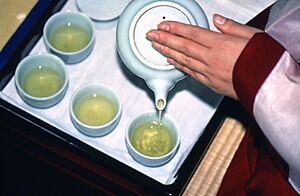
nokcha (green tea)
|
|
Quick facts for kids Korean name |
|
|---|---|
| Hangul | |
| Hanja | |
| Revised Romanization | jeontong-cha |
| McCune–Reischauer | chŏnt'ong-ch'a |
| IPA | [tɕʌn.tʰoŋ.tɕʰa] |
Korean tea is a special drink made by soaking different parts of plants in hot water. It can be made from leaves (like the tea plant), roots, flowers, fruits, grains, or even edible mushrooms and seaweed. Sometimes, it doesn't even have tea leaves from the actual tea plant!
The Story of Korean Tea

The history of tea in Korea is quite old! Some stories say that a legendary queen named Heo Hwang-ok brought the tea plant from India to Korea a very long time ago. She supposedly planted it on a mountain called Baegwolsan. However, back then, people mostly drank teas made from fruits or other plants, like magnolia berry tea.
Later, Buddhist monks helped spread tea culture in Korea. They brought ideas about tea from China. Some of the oldest Buddhist temples in Korea, like Bulgapsa, say they are where Korean tea culture began.
Tea from China started coming to Korea around 631-647 AD, during the time of Queen Seondeok of Silla. Two types of pressed tea, called jeoncha and dancha, were imported from the Tang Empire. In 765, a Buddhist monk even offered tea to King Gyeongdeok and the Buddha.
The actual tea plants spread across Korea in 828 AD. King Heungdeok received tea seeds from the Tang Empire and had them planted on Jirisan mountain. Tea was often used as an offering to the Buddha and to the spirits of family members who had passed away.
Tea culture continued to grow during the Goryeo Dynasty. Tea offerings were a big part of national events. Tea shops even accepted coins! Scholars and thinkers also enjoyed writing poems about tea and holding tea meetings. They believed that tea and meditation went together.
During the Joseon Dynasty (1392-1910), tea became more common for everyone, not just monks or royalty. The royal family used tea for simple ceremonies called darye, which means "tea rite." Later, regular people also started using tea for ceremonies to honor their ancestors. Wedding ceremonies also included tea.
In 1895, King Gojong was the first to try coffee. After that, tea rooms started appearing in grocery stores, and the first modern tea house opened in 1924.
Tea Today
Even though South Korea drinks a lot more coffee than tea, grain teas are still very popular. Many restaurants serve them instead of water. You can also find many herbal and fruit teas, served both hot and cold.
Different Kinds of Korean Tea
There are many different kinds of Korean tea, made from various plants and ingredients!
Teas from the Tea Plant (Camellia sinensis)
These teas are made from the leaves of the actual tea plant.
Not Oxidized (Green Tea)
- Nokcha (녹차; "green tea")
Green tea is the most common type of tea made from tea leaves in Korea. It's not oxidized, meaning the leaves aren't allowed to change color much after being picked. Nokcha can be sorted by when the leaves are picked. For example, ujeon is picked before the rain, and daejak uses bigger leaves picked later. Loose leaf tea is called ipcha, and powdered tea is garu-cha. Most Korean green tea is roasted (deokkeum-cha) rather than steamed. Places like Boseong and Jeju are famous for their high-quality tea leaves. Nokcha can also be mixed with other things, like roasted brown rice to make hyeonmi-nokcha.
Partially Oxidized (Yellow Tea)
- Hwangcha (황차; "yellow tea")
This tea is made from tea leaves that are only partly oxidized. It's somewhere between green tea and black tea. The special way it's oxidized gives it a unique taste.
Fully Oxidized (Red Tea)
- Hongcha (홍차; "red tea")
This tea is fully oxidized, which makes the leaves dark. In Korea (and China and Japan), it's called "red tea" because of the color of the brewed drink. Jaekseol-cha is a traditional red tea from Hadong.
Post-Fermented Teas
- Tteokcha (떡차; "cake tea") or byeongcha (병차; "cake tea")
This is a tea that has been fermented after being processed, and then pressed into a brick or cake shape. Borim-cha is a well-known type of tteokcha.
- Doncha (돈차; "money tea") or cheongtaejeon (청태전; "green moss coin")
This is another post-fermented tea pressed into the shape of old Korean coins with holes in the middle.
Other Leaf Teas
These teas are made from the leaves of plants other than the Camellia sinensis tea plant.
| Tea | Korean name | Image | Ingredient |
|---|---|---|---|
| Baegyeop-cha (pine leaf tea) |
백엽차 (柏葉茶) | Korean pine needles | |
| Baeksan-cha (white mountain tea) |
백산차 (白山茶) | Labrador tea leaves | |
| Bakha-cha (mint tea) |
박하차 (薄荷茶) | 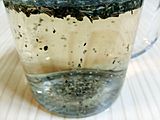 |
East Asian wild mint leaves |
| Daennip-cha (bamboo leaf tea) |
댓잎차 | 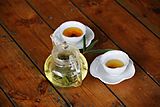 |
Bamboo leaves |
| Gamnip-cha (persimmon leaf tea) |
감잎차 | 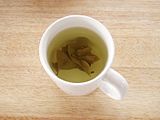 |
Oriental persimmon leaves |
| Hwangsan-cha (rosebay tea) |
황산차 (黃酸茶) | Lapland rosebay leaves | |
| Iseul-cha (dew tea) Gamno-cha (sweet dew tea) |
이슬차 감로차 (甘露茶) |
mountain hydrangea leaves | |
| Maegoe-cha (rugose rose tea) |
매괴차 (玫瑰茶) | rugose rose leaves | |
| Mulssuk-cha (mugwort tea) |
물쑥차 | common mugwort | |
| Ppongnip-cha (mulberry leaf tea) |
뽕잎차 | 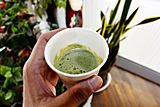 |
white mulberry leaves |
| Seombaengnihyang-cha (thyme tea) |
섬백리향차 |  |
Ulleungdo thyme |
| Sollip-cha (pine leaf tea) |
솔잎차 | 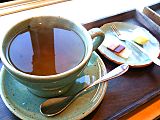 |
Korean red pine needles |
| Ssukcha (mugwort tea) |
쑥차 | 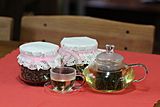 |
Korean mugwort |
| Yeonnip-cha (lotus leaf tea) |
연잎차 | 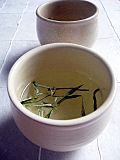 |
lotus leaves |
Flower Teas
These teas are made from different kinds of flowers.
| Tea | Korean name | Image | Ingredient |
|---|---|---|---|
| Dohwa-cha (peach flower tea) |
도화차 (桃花茶) | 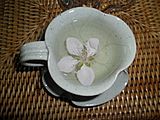 |
peach blossoms |
| Goehwa-cha (pagoda flower tea) |
괴화차 (槐花茶) | pagoda flowers | |
| Gujeolcho-cha (dendranthema tea) |
구절초차 (九節草茶) | 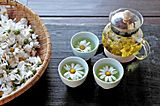 |
white-lobe Korean dendranthema flowers |
| Gukhwa-cha (chrysanthemum tea) |
국화차 (菊花茶) |  |
Indian chrysanthemum flowers |
| Gyehwa-cha (cinnamon flower tea) |
계화차 (桂花茶) | Chinese cinnamon flowers | |
| Gyulhwa-cha (citrus flower tea) |
귤화차 (橘花茶) | citrus flowers | |
| Maehwa-cha (plum flower tea) |
매화차 (梅花茶) | 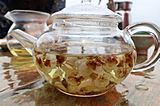 |
Chinese plum blossoms |
| Mindeulle-cha (dandelion tea) |
민들레차 | 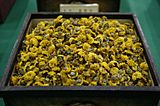 |
Korean dandelion |
| Mongnyeon-cha (magnolia tea) |
목련차 (木蓮茶) |  |
kobus magnolia flowers |
| Yeonkkot-cha (lotus flower tea) Yeonhwa-cha (lotus flower tea) |
연꽃차 연화차 (蓮花茶) |
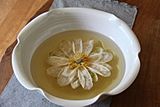 |
lotus flowers |
Fruit Teas
These teas are made from different kinds of fruits.
| Tea | Korean name | Image | Ingredient |
|---|---|---|---|
| Daechu-cha (jujube tea) |
대추차 | 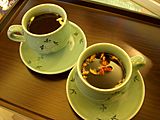 |
jujube |
| Gugija-cha (goji tea) |
구기자차 (枸杞子茶) | goji berries | |
| Gyulpi-cha (citrus peel tea) |
귤피차 (橘皮茶) | citrus peels | |
| Hobak-cha (pumpkin tea) |
호박차 | 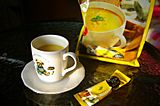 |
cheese pumpkin |
| Maesil-cha (plum tea) |
매실차 (梅實茶) |  |
Chinese plums |
| Mogwa-cha (quince tea) |
모과차 | 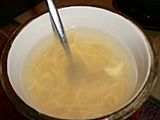 |
Chinese quince |
| Ogwa-cha (five fruit tea) |
오과차 (五果茶) | walnut ginkgo jujube chestnut dried persimmon |
|
| Omae-cha (smoked plum tea) |
오매차 (烏梅茶) | smoked plums | |
| Omija-cha (magnolia berry tea) |
오미자차 (五味子茶) |  |
magnolia berries |
| Sansuyu-cha (cornelian cherry tea) |
산수유차 (山茱萸茶) | cornelian cherry | |
| Seongnyu-cha (pomegranate tea) |
석류차 (石榴茶) | 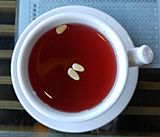 |
pomegranates |
| Taengja-cha (hardy orange tea) |
탱자차 | hardy oranges | |
| Yuja-cha (yuja tea) |
유자차 (柚子茶) |  |
yuja |
Grain, Bean, and Seed Teas
These teas are made from grains, beans, or seeds.
| Tea | Korean name | Image | Ingredient |
|---|---|---|---|
| Bori-cha (barley tea) |
보리차 | 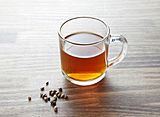 |
barley |
| Gyeolmyeongja-cha (sicklepod tea) |
결명자차 (決明子茶) |  |
sicklepods |
| Hyeonmi-cha (brown rice tea) |
현미차 (玄米茶) | 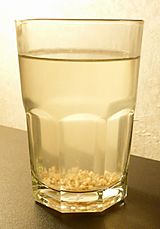 |
brown rice |
| Memil-cha (buckwheat tea) |
메밀차 | 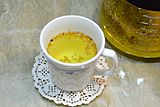 |
buckwheat |
| Misu-cha (rice tea) |
미수차 | rice | |
| Nokdu-cha (mung bean tea) |
녹두차 (綠豆茶) | mung beans | |
| Oksusu-cha (corn tea) |
옥수수차 |  |
corn kernels |
| Yulmu-cha (Job's tears tea) |
율무차 | 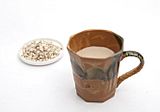 |
Coix lacryma-jobi var. ma-yuen |
Root, Shoot, and Bark Teas
These teas are made from the roots, shoots, or bark of plants.
| Tea | Korean name | Image | Ingredient |
|---|---|---|---|
| Danggwi-cha (angelica root tea) |
당귀차 (當歸茶) | Korean angelica root | |
| Doraji-cha (balloon flower root tea) |
도라지차 | 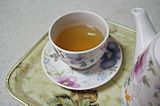 |
balloon flower root |
| Dunggulle-cha (Solomon's seal tea) |
둥굴레차 | Solomon's seal root | |
| Chikcha / Galgeun-cha (arrow root tea) |
칡차 갈근차 (葛根茶) |
East Asian arrow root | |
| Gyepi-cha (cinnamon tea) |
계피차 (桂皮茶) | Chinese cinnamon bark | |
| Hongsam-cha (red ginseng tea) |
홍삼차 (紅蔘茶) | red ginseng | |
| Insam-cha (ginseng tea) |
인삼차 (人蔘茶) | Korean ginseng | |
| Macha (yam tea) |
마차 (麻茶) | 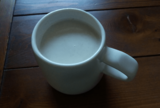 |
Chinese yam |
| Misam-cha (ginseng root hair tea) |
미삼차 (尾蔘茶) | Korean ginseng root hair | |
| Saenggang-cha (ginger tea) |
생강차 (生薑茶) |  |
ginger |
| Ueong-cha (burdock tea) |
우엉차 | burdock roots | |
| Yeongeun-cha (lotus root tea) |
연근차 (蓮根茶) |  |
lotus root |
Mixed and Other Teas
These teas combine different ingredients or are made from unique sources.
| Tea | Korean name | Image | Ingredient |
|---|---|---|---|
| Beoseot-cha (mushroom tea) |
버섯차 |  |
edible mushrooms |
| Dasima-cha (kelp tea) |
다시마차 | kelp | |
| Donga-cha (wintermelon tea) |
동아차 | winter melon flesh winter melon seeds |
|
| Giguk-cha (goji chrysanthemum tea) |
기국차 (杞菊茶) | northern dendranthema goji berries black sesame seeds jakseol green tea leaves milk |
|
| Gyulgang-cha (citrus ginger tea) |
귤강차 (橘薑茶) | 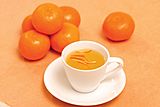 |
citrus fruit pyeongang |
| Hyeonmi-nokcha (brown rice green tea) |
현미녹차 (玄米綠茶) | brown rice green tea leaves |
|
| Jeho-tang | 제호탕 (醍醐湯) | smoked plums medicinal cardamom white sandalwood black cardamom honey |
|
| Podo-cha (grape tea) |
포도차 (葡萄茶) | grapes Korean pear ginger honey |
|
| Ssanghwa-tang | 쌍화탕 (雙和湯) | 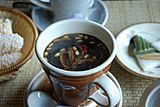 |
white woodland peony root rehmannia root Mongolian milkvetch root Korean angelica root lovage root Chinese cinnamon bark Chinese liquorice |
| Sunchae-cha (watershield tea) |
순채차 (蓴菜茶) | watershield leaves magnolia berry-infused water honey pine nuts |
See also
 In Spanish: Té coreano para niños
In Spanish: Té coreano para niños

